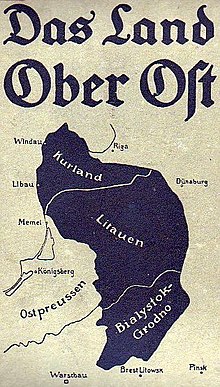Upper East Mark
The high east-Mark was 1918-1922 a currency in the occupied areas of Germany of the Baltic , the Memel and Lithuania .
With the victories in the Battle of Tannenberg , the Battle of the Masurian Lakes and the Winter Battle in Masuria , the German Empire had averted the danger of a Russian attack on East Prussia in 1914/15 and at the same time occupied important areas of the (then Russian) Baltic States. Administratively, the area was administered from November 1915 by the staff of the Commander-in-Chief East and referred to as Ober Ost .
A separate currency, the East Mark or Upper East Mark and the East Ruble (which survived the end of the war) as well as its own overprint stamps, were issued and used for the Upper East area.
For this purpose, banknotes from the Eastern Loan Fund with the nominal values of 50 Pfennig, 1 Mark, 2 Mark, 5 Mark, 20 Mark, 50 Mark, 100 Mark and 1000 Mark were issued.
The Upper East Mark was tied to the Mark and therefore enjoyed a high level of public acceptance. After the end of the war, the newly formed state of Lithuania took over the Upper East Mark as its currency . The currency was also used in Memelland alongside the emergency money from the Memel Chamber of Commerce . With the German inflation , the Upper East Mark also lost value. In June 1922, therefore, the young Republic of Lithuania introduced its own national currency, the Lithuanian litas . The introductory rate for the new Lithuanian currency was 10 litas = 1 US dollar .
In 1923 the Memel area was occupied by Lithuania. On June 1, 1923, the litas was therefore also introduced here.
literature
- Wilhelm Georg Kapust: The development of the Memelland economy since the separation from the German Empire with special consideration of the currency and credit conditions, Diss., 1928
Individual evidence
- ^ Jürgen Lewerenz: Banks in the Baltic States. Yesterday Today Tomorrow. With reason and decency out of necessity to inner balance and to successful cooperation between East and West. Role models from Baltic history as a guide for rebuilding a bourgeois order. Fritz Knapp Verlag, Frankfurt am Main 1997, ISBN 3-7819-0590-X , p. 70.
- ↑ Listed in every Michel Germany special catalog, keyword German occupation issues 1914–1918 (postal area Ob. Ost)



